
Moxico or Moshiko is the largest province of Angola. It has an area of 223,023 square kilometres (86,110 sq mi), and covers 18% of the landmass of Angola. The province has a population of 758,568 and a population density of approximately 3.4 residents per km², making it one of the most sparsely populated areas of Angola. The population of the province is in flux; displaced residents have slowly returned to Moxico since the end of the Angolan Civil War in 2002. The war left Moxico as one of the most landmine-contaminated places in the world. The governor of the province is Gonçalves Manuel Muandumba.

Dilolo Lake is the largest lake in Angola. It is located in Moxico Province. The lake is located right outside of Cameia National Park.
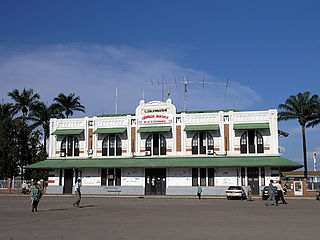
The Société Nationale des chemins de fer du Congo is the national railway company for the inland railways of the Democratic Republic of the Congo.
Luau is a town and municipality in Angola in the province of Moxico on the border with the Democratic Republic of Congo.
Lumeje is a municipality in Moxico Province, Angola. The seat of the municipality is Lumeje Kameia. It is notable for its national park. Lumeje and Lucano form the boundaries of the park. Cameia National Park was established as a game reserve in 1938 and proclaimed a national park in 1957. The municipality is the location site of two lakes, Lago Cameia and Lago Dilolo, the largest lake in Angola. It had a population of 29,476 in 2014.
Cameia National Park is a national park in the Moxico province of Angola, located at about 1100 m above sea level. Covering a surface of 14.450 km2. It shares its name with the nearby municipality of Cameia. The Cameia–Luacano road forms the northern boundary of the park with the Chifumage River forming the southern portion of the eastern boundary and the Lumege and Luena rivers the south-western boundary.
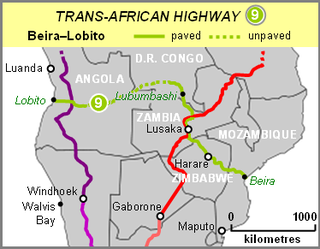
The Beira–Lobito Highway or TAH 9 is Trans-African Highway 9 in the transcontinental road network being developed by the United Nations Economic Commission for Africa (UNECA), the African Development Bank (ADB), and the African Union. The route has a length of 3,523 km (2,189 mi) crossing Angola, the most southerly part of the Democratic Republic of the Congo, Zambia, Zimbabwe, and central Mozambique.

Railway stations in Angola include:
Divuma is a town in the Lualaba province of the Democratic Republic of the Congo, near the border with Zambia.
Dilolo Airport is an airstrip in Dilolo, Lualaba Province, Democratic Republic of the Congo. The runway is 7.5 kilometres (4.7 mi) south of the town, near the Angola border.
Luau International Airport is an airport serving Luau, a municipality in the Moxico Province of Angola. It is 6.5 kilometres (4.0 mi) west of the city, and may replace the Villa Teixeira de Sousa Airport, an unpaved airstrip that is within the city.
Lago-Dilolo is a town and commune of Angola, located in the province of Moxico.
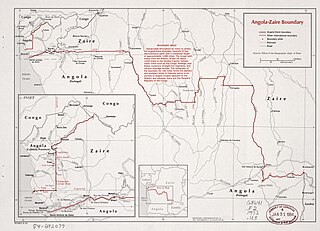
The Angola–Democratic Republic of the Congo border is 2,646 km in length and consists of two non-contiguous sections: a 225 km section along the border with Angola's province of Cabinda, running from the Atlantic Ocean to the tripoint with the Republic of Congo, and a much longer 2,421 km section running from the Atlantic to the tripoint with Zambia.
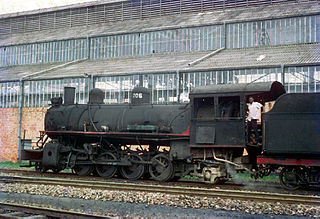
The Compagnie du chemin de fer du bas-Congo au Katanga (BCK) was a railway operator in the Congo Free State, Belgian Congo and later in the Democratic Republic of the Congo and Zaire. Most of the lines were in the southern Katanga Province, with links to the Kasai River for transport of mineral exports down to Kinshasa and onward to the port of Matadi, and a link to the Angolan railway network for transport to Lobito on the Atlantic.
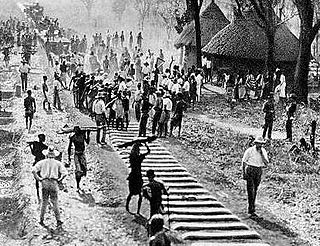
The Compagnie de Chemin de fer du Katanga (CFK) was a railway company in the Congo Free State and Belgian Congo between 1902 and 1952. It held the railway concession that linked the port of Bukama on the navigable section of the Lualaba River through the mining region and the town of Elisabethville (Lubumbashi) to Sakania, where it connected with the Rhodesian railway network. Operations were subcontracted to the Compagnie du chemin de fer du bas-Congo au Katanga (BCK).
The Société des Chemins de fer Léopoldville-Katanga-Dilolo (LKD) was a railway concession owner in the Congo Free State, Belgian Congo. The network was built, maintained and operated by the Compagnie du chemin de fer du bas-Congo au Katanga (BCK).
The Société des Chemins de fer Katanga-Dilolo-Léopoldville (KDL) was a railway concession owner in the Congo Free State, Belgian Congo. The network was built, maintained and operated by the Compagnie du chemin de fer du bas-Congo au Katanga (BCK).
The Luao River forms part of the boundary between Angola and the Democratic Republic of the Congo. It is a right tributary of the Kasai River.










